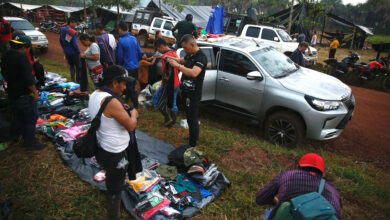The countryside: Plan B for many Ukrainians

By Rostyslav Averchuk
Lviv, Ukraine, Nov 28 (EFE).- As Ukraine braces for winter while Russian missile attacks continue, some cities are asking their residents to be ready to move to villages in the countryside, which provide a certain degree of autonomy from the country’s centralized supply services but also suffer from power outages.
The road from Lviv to the village of Sokolia near the Polish border is pitch dark. The only lights come from the passing cars and the occasional illuminated chapels along the roadside. Just like the cities, much of the countryside has been plunged into darkness.
“Even the German Nazis didn’t make the civilians suffer as much as the Russians do,” Ivan, a 61-year-old man, told EFE in an interview.
The memories of the world war, passed down through generations, inevitably come to his mind.
He said he feels in a better position than many residents of the eastern and southern Ukrainian regions, which have been devastated by the Russian invasion.
“I have gas-powered heating so at least it’s warm inside,” he said.
With a well in his yard, Ivan doesn’t have to worry about his supply of water either. This year’s harvest from his garden, more than 30 beehives, a patch of arable land, as well as two cows and free-roaming chickens also provide him with a certain autonomy when it comes to food.
But there is no way of escaping the effects of the deliberate Russian missile strikes against Ukraine’s civilian infrastructure as the resulting emergency power outages have left the village without electricity for 10-12 hours on each of the last 10 days.
One of the problems the townspeople are facing is that their freezers are struggling to maintain the required low temperature, with meat and other products going bad faster.
Ivan said he was especially worried about what will happen if Russia starts shelling the gas transmission system. He disassembled the firewood ovens he had inside his home back in the early 2000s after the village was linked to the gas line.
“It’s a catastrophe,” said Igor, Ivan’s neighbor. Together with his wife, Slava, he moved to the countryside from Lviv years ago to live closer to nature. Now he has to worry about making it through the winter.
Igor is looking to buy a power generator for his home like some of the locals already did. It may be more difficult now as the demand from Ukraine means generators are becoming scarce even in the neighboring countries and are ever more expensive.
“In any case, it will only be a partial solution as it can only work for several (consecutive) hours … while we might have to live without electricity for days,” he said.
Igor has also been affected by the death of his wife’s nephew, who was killed during combat in the Donbas, and he worries it may take years to repair the damage to infrastructure caused by the Russians.
At least, he still has firewood stoves inside his home. Despite the lack of wood and soaring prices, Igor did manage to get some logs that he still has to cut and dry out.
Suffering from a fever for the last few days, Igor said he lacks the energy and the time to complete the job yet still has to go to work at a nearby fishing resort.
Meanwhile, long rows of firewood are stacked against the front wall of a nearby dacha. Countryside homes, owned by some city residents who used to have relatives in a village, serve as a backup option to many.
Some mayors, including Vitaliy Klitschko from Kyiv and Ivan Martsynkiv from Ivano-Frankivsk, have already asked the locals to move to the suburbs or villages where they could have independent an water supply and heating, thus taking some pressure off the city infrastructure.
Many will postpone the move for as long as possible, however, unwilling to leave their homes and the more developed infrastructure in cities. But they may have few options as the mayors are warning that heated sites, the establishment of which is just getting under way, will not be enough to handle the demand in the case of longer blackouts amid freezing temperatures.





